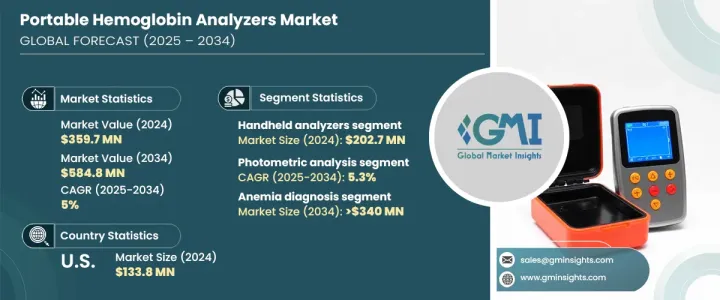
휴대용 헤모글로빈 분석기 세계 시장은 2024년 3억 5,970만 달러로 평가되었으며, 2025년부터 2034년까지 연평균 복합 성장률(CAGR) 5%로 성장할 것으로 예상됩니다.
이 성장 궤도는 빈혈 및 기타 헤모글로빈 관련 건강 상태의 세계 유병률의 상승으로 이어집니다. 사용하기 쉽고 빠르고 정확한 진단 솔루션에 대한 수요 증가는 현대 건강 관리에서 휴대용 헤모글로빈 분석기의 중요성 증가를 뒷받침합니다. 헬스케어 문제에 대한 의식이 높아짐에 따라, 의료 종사자를 지원하고 환자의 예후를 개선하는 포인트 오브 케어 검사 기기의 채용도 진행되고 있습니다. 이러한 분석 장비는 도시 및 원격 지역의 사람들의 진단 요구를 충족시키는 데 필수적인 도구이며, 세계 의료 인프라의 중요한 격차를 메우는 것입니다.

빈혈은 세계의 건강 문제이며 특히 여성, 어린이, 노인을 중심으로 수십억 명에 영향을 미칩니다. 휴대용 헤모글로빈 분석기는 조기 진단과 적시 개입을 지원하는 빠르고 안정적인 결과를 제공하고 중요한 솔루션을 제공합니다. 이 장비의 휴대성과 사용 편의성은 전통적인 검사 시설에 대한 접근이 제한된 충분한 서비스를 제공하지 않는 원격지에서 필수적입니다. 세계 정부 및 건강 관리 기관은 특히 의료 인프라가 부족한 지역에서 빈혈의 조기 발견과 효과적인 관리를 점점 제창하고 있습니다. 이러한 진단 능력 강화의 움직임은 휴대용 헤모글로빈 분석기 수요를 크게 밀어 올려 건강 관리에 대한 접근성과 공정성 향상에 기여하고 있습니다.
| 시장 범위 | |
|---|---|
| 시작 연도 | 2024년 |
| 예측 연도 | 2025-2034년 |
| 시작 금액 | 3억 5,970만 달러 |
| 예측 금액 | 5,848억 달러 |
| CAGR | 5% |
시장은 핸드헬드형과 벤치탑형의 2가지 제품 유형으로 분류됩니다. 2024년 핸드헬드형 분석기의 매출은 2억 270만 달러로 주요 부문으로 자리매김하고 있습니다. 컴팩트한 디자인, 합리적인 가격, 사용하기 쉬운 기능은 현지 클리닉, 응급실 외, 재택 건강 관리 등과 같은 포인트 오브 케어에 특히 적합합니다. 휴대용 분석기가 제공하는 신속하고 정확한 결과는 빈혈 및 기타 관련 질환을 관리하는 의료 종사자에게 유용하며 현대 진단에서 중요한 역할을 담당합니다.
휴대용 헤모글로빈 분석기의 용도는 빈혈 진단, 만성 질환 모니터링 및 기타 용도에 적용됩니다. 빈혈 진단 분야는 CAGR 5.2%로 가장 높은 성장을 이루며, 2034년에는 3억 4,000만 달러에 달할 것으로 예상됩니다. 이 강력한 성장의 원동력이 되고 있는 것은 세계에서 빈혈의 발생률이 높아지고 있는 것이며, 특히 사회적 약자에 있어서의 빈혈의 발생률이 높아지고 있습니다. 휴대형 헤모글로빈 분석기는 건강 상태 개선에 필수적인 조기 발견·조기 관리를 촉진하는데 혁신적인 역할을 하고 있습니다. 그 중요성은 빈혈이 공중 보건의 중요한 문제로 뿌리 깊게 남아있는 선진 지역과 개발 도상 지역 모두에 걸쳐 있으며,이 장비의 세계의 중요성을 강조합니다.
미국에서 휴대용 헤모글로빈 분석기 시장은 2024년에 1억 3,380만 달러로 평가되었으며, 2034년까지 연평균 복합 성장률(CAGR) 4.4%로 성장할 것으로 예측됩니다. 미국은 견고한 헬스케어 시스템과 예방의료 중시의 고조에 힘입어 이러한 기기에 있어서 매우 중요한 시장인 것에 변함이 없습니다. 특히 여성, 소아, 노인의 빈혈 확산은 신뢰할 수 있는 진단 솔루션에 대한 수요를 계속 견인하고 있습니다. 휴대용 헤모글로빈 분석기는 신속하고 효율적인 결과를 제공함으로써 이러한 요구를 충족시키고 적시에 의료 개입을 가능하게 하며 전국 환자의 건강 상태 개선을 촉진합니다.
The Global Portable Hemoglobin Analyzers Market, valued at USD 359.7 million in 2024, is poised for steady growth at a CAGR of 5% from 2025 to 2034. This growth trajectory is driven by the escalating prevalence of anemia and other hemoglobin-related health conditions worldwide. The rising demand for accessible, rapid, and accurate diagnostic solutions underscores the increasing importance of portable hemoglobin analyzers in modern healthcare. As awareness of healthcare issues grows, so does the adoption of point-of-care testing devices that empower healthcare providers and enhance patient outcomes. These analyzers offer an essential tool for addressing the diagnostic needs of both urban and remote populations, bridging critical gaps in global healthcare infrastructure.

Anemia continues to be a pervasive global health challenge, affecting billions of individuals, particularly women, children, and elderly populations. Portable hemoglobin analyzers provide a vital solution, delivering quick and reliable results that support early diagnosis and timely intervention. The devices' portability and ease of use make them indispensable in underserved and remote areas where access to traditional laboratory facilities is limited. Governments and healthcare organizations worldwide are increasingly advocating for early detection and effective management of anemia, particularly in regions with inadequate medical infrastructure. This push for enhanced diagnostic capabilities has significantly bolstered the demand for portable hemoglobin analyzers, contributing to improved healthcare access and equity.
| Market Scope | |
|---|---|
| Start Year | 2024 |
| Forecast Year | 2025-2034 |
| Start Value | $359.7 Million |
| Forecast Value | $584.8 Billion |
| CAGR | 5% |
The market is categorized into two primary product types: handheld analyzers and benchtop analyzers. In 2024, handheld analyzers generated USD 202.7 million in revenue, solidifying their position as the leading segment. Their compact design, affordability, and user-friendly features make them particularly suited for point-of-care settings such as rural clinics, emergency rooms, and home healthcare environments. The rapid and precise results provided by handheld analyzers are instrumental for healthcare providers managing anemia and other related conditions, underscoring their critical role in modern diagnostics.
Applications of portable hemoglobin analyzers span anemia diagnosis, chronic disease monitoring, and other uses. The anemia diagnosis segment is expected to achieve the highest growth, with a CAGR of 5.2%, and reach USD 340 million by 2034. This robust growth is fueled by the rising incidence of anemia across the globe, especially in vulnerable populations. Portable hemoglobin analyzers play a transformative role in facilitating early detection and management, which is crucial for improving health outcomes. Their importance extends across both developed and developing regions, where anemia persists as a significant public health issue, underscoring the global relevance of these devices.
In the United States, the portable hemoglobin analyzers market was valued at USD 133.8 million in 2024 and is anticipated to grow at a CAGR of 4.4% through 2034. The U.S. remains a pivotal market for these devices, supported by a robust healthcare system and an increasing emphasis on preventive care. The prevalence of anemia, particularly among women, children, and older adults, continues to drive the demand for reliable diagnostic solutions. Portable hemoglobin analyzers address this need by offering quick and efficient results, enabling timely medical interventions, and fostering better health outcomes for patients across the country.